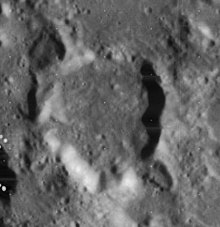
Beaumont is a lava-flooded crater located on the southwestern shore of the Mare Nectaris on Earth's Moon. It lies to the northwest of the similarly flooded crater remnant Fracastorius. To the west is the prominent crater Catharina. The crater is named after French geologist Léonce Élie de Beaumont.

Fracastorius is the lava-flooded remnant of an ancient lunar impact crater located at the southern edge of Mare Nectaris. To the northwest of this formation lies the crater Beaumont, while to the northeast is Rosse.
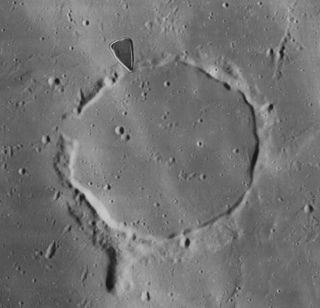
Kies is the remnant of a lunar impact crater that has been flooded by basaltic lava, leaving only a remnant of the outer rim. It was named after German mathematician and astronomer Johann Kies. It is located in the Mare Nubium almost due south of the crater Bullialdus. Northwest of Kies is König. To the south-southwest lies a lunar dome structure designated Kies Pi (π). It has a small crater at the top and is most likely volcanic in origin.
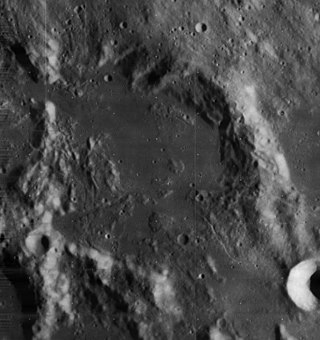
Murchison is a lunar impact crater on the north edge of the Sinus Medii. It was named in honour of the geologist Sir Roderick Murchison. It shares a section of rim with the crater Pallas. To the southeast on the mare is the circular crater Chladni, and to the northeast is Ukert. Farther to the east is the prominent Triesnecker. Murchison lies astride the lunar zenith line, i.e. the starting longitude of the selenographic coordinate system.

Carrel is a small lunar crater on the Mare Tranquillitatis. It has a somewhat distorted appearance, having a slight protruding bulge in the northwest rim. The interior is somewhat irregular, with ridges and some slumped material. This crater lies across a ridge in the surface of the mare.

Doppelmayer is the remains of a lunar impact crater that lies on the southwest edge of Mare Humorum. It was named after the German mathematician and astronomer Johann Gabriel Doppelmayr. To the south-southeast is another flooded crater designated Lee, and to the southeast is Vitello. Just to the east-northeast of Doppelmayer lies the nearly submerged crater Puiseux.
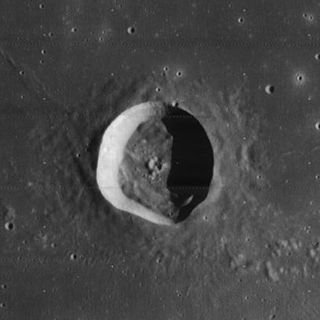
Flamsteed is a small lunar impact crater located on the Oceanus Procellarum, which is named after British astronomer John Flamsteed. It lies almost due east of the dark-hued Grimaldi, and north-northwest of the flooded Letronne bay on the south edge of the mare.

Babcock is a lunar impact crater that is located on the far side of the Moon. It was named after American astronomer Harold D. Babcock. It lies on the northeastern edge of Mare Smythii, to the southeast of Mare Marginis. To the south of Babcock is the crater Purkynĕ, and to the east-northeast lies Erro. Babcock is located in a region of the Moon's surface that is occasionally brought into view during favorable librations, although it is seen from the edge and so little detail can be discerned from an observer on the Earth.

Baillaud is a lunar impact crater that is located near the north limb of the Moon. The rim of the crater has been eroded and worn by a long history of impacts, leaving a hilly ridge surrounding the interior. The crater Euctemon is intruding into the rim to the northeast, and the rim bulges outward to the northwest. At the south end of the crater is a gap connecting to the lava-flooded surface to the south.

Byrd is an irregular lunar impact crater that is located near the north pole of the Moon. The north rim of Byrd is nearly connected to the crater Peary, a formation that is adjacent to the pole. The smaller crater Gioja is attached to the remains of the southwest rim.
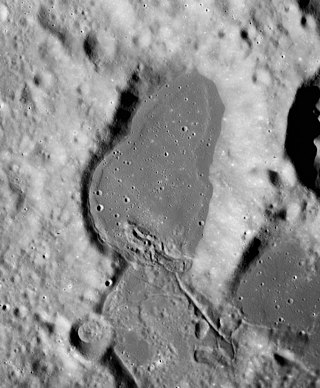
Bowditch is a lunar impact crater that lies on the far side of the Moon, just beyond the eastern limb. It is located on a region of the lunar surface that is brought into view due to libration, but at such times the area is viewed from the edge and so not much detail can be observed. It lies just to the north of the small Lacus Solitudinis lunar mare, between the craters Titius to the southwest and Perel'man to the east-northeast.

Desargues is an ancient lunar impact crater that is located near the northern limb of the Moon, on the western hemisphere. It lies nearly due south of the crater Pascal, and southeast of Brianchon. The proximity of this crater to the limb means that it appears highly elongated due to foreshortening, and it is difficult to discern details from the Earth.
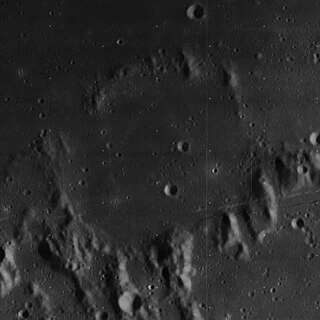
Oppolzer is the remnant of a lunar impact crater that is located on the southern edge of Sinus Medii, along the meridian of the Moon. Its diameter is 41 km. It was named after the Austrian astronomer Theodor von Oppolzer. It is located within one crater diameter of the origin of the selenographic coordinate system at 0° N, 0° W. Attached to the surviving remnants of the southeast rim is the crater Réaumur. To the west-southwest is the lava-flooded walled plain Flammarion.
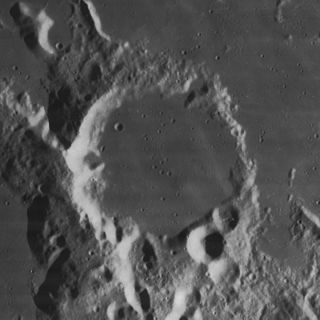
Capuanus is a lunar impact crater that lies along the southern edge of the Palus Epidemiarum. It was named after Italian astronomer F. Capuano di Manfredonia. The outer rim is eroded and indented by lesser crater impacts, with notches in the north, west, and southern parts of the rim. The interior floor has been resurfaced by basaltic lava, which is connected to the surrounding lunar mare by a narrow, crater-formed gap in the northern rim. Dotting the floor of the crater are a number of domes, which are believed to have formed through volcanic activity.
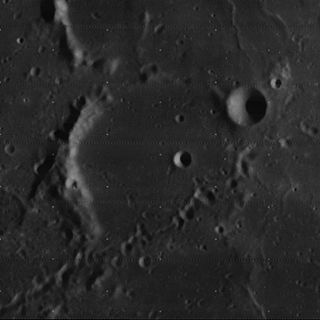
Gould is the remnant of a lunar impact crater formation that lies in the midst of the Mare Nubium, in the southwest quadrant of the Moon. It was named after American astronomer Benjamin A. Gould. It is located to the east-northeast of the prominent crater Bullialdus, and south of the crater remnant Opelt.

Elger is a lunar impact crater that lies along the southern edge of Palus Epidemiarum, the Marsh of Epidemics, in the southwest part of the Moon's near side. To the northeast is the flooded crater Capuanus, and farther to the northwest is Ramsden.
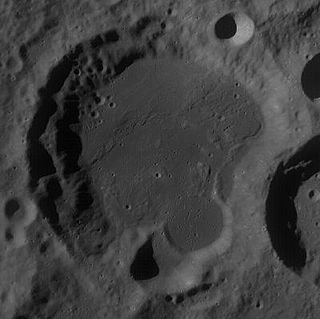
Crocco is a lunar impact crater that is located on the far side of the Moon from the Earth. It is located to the northeast of the huge walled plain Planck, and northwest of the equally huge Poincaré. Just to the north, within one crater diameter, is the crater Koch.

Chevallier is a lunar impact crater that is located in the northeastern part of the Moon's near side, about a crater diameter east-southeast of the prominent crater Atlas. To the south-southeast of Chevallier is the flooded crater Shuckburgh.

Cichus is a lunar impact crater that lies in the southwestern part of the Moon, at the eastern edge of Palus Epidemiarum. Just to the northeast and nearly contacting the rim is the lava-flooded crater remnant Weiss. The crater is named after Italian astronomer Cecco d'Ascoli.
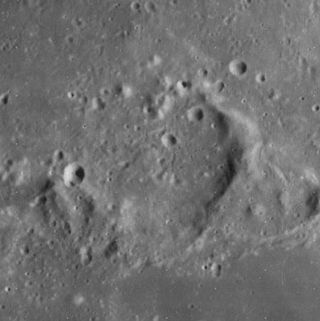
Williams is the remnant of a lunar impact crater that lies to the south of the prominent crater Hercules, in the northeastern part of the Moon. The southern rim borders the Lacus Somniorum, a small lunar mare that extends to the south and west. To the southwest is the sharp-rimmed crater Grove.
